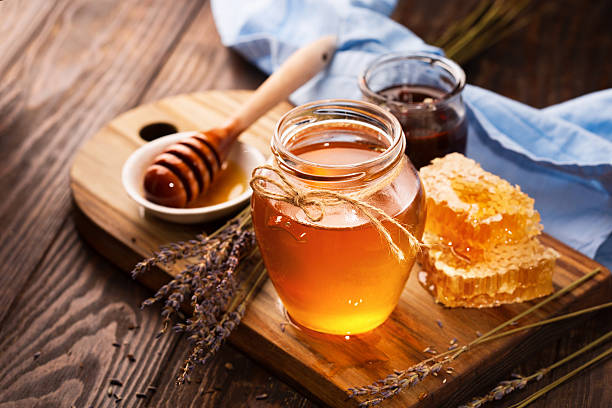It is believed that the practice of beekeeping and honey consumption has been part of human culture for at least 8,000 years. Honey bees, primarily the Apis mellifera species, gather nectar from flowers, which they transform into honey through a remarkable process of regurgitation and evaporation in their hives. Further, beekeepers harvest honey by extracting combs from the hives, and this liquid gold has since found its way into numerous honey products.
The Most Renowned Varieties of Honey
1. Wildflower Honey
Wildflower honey, as its name suggests, is a type sourced from the nectar of a wide variety of blooming flowers. These flowers can include clover, alfalfa, lilac, goldenrod, aster, hydrangea, and more. Further, the certain flower types present in wildflower honey can vary depending on the climate of the region.
Late Season Richness
In contrast, late-season wildflower honey presents a distinct character. The nectar collected during this period comes from fall flowers and sap flows. As a result, the honey develops rich, deep flavors that are prized by those who enjoy honey with a delightful taste. Besides, late-season wildflower honey carries the essence of:
- The autumnal landscape
- Diverse autumn floral offerings
The Terroir of Wildflower Honey
One of the standout features of wildflower honey is its ability to encapsulate the regional tastes of its terroir. Terroir refers to the unique environmental factors of a specific location that influence the flavor of agricultural products.
In the case of wildflower honey, the mix of local flora, climate, and geographical conditions contributes to its ever-changing taste profile.
Interesting Facts
- Health Benefits:
The honey contains antioxidants and has antibacterial properties, which can help soothe sore throats and coughs. Additionally, some people believe that consuming local wildflower honey may provide relief from seasonal allergies.
- Versatile Uses:
You know what? It is a versatile ingredient in the kitchen. Therefore, it can be used in diverse culinary applications, from sweetening tea and coffee to drizzling over desserts and adding flavor to salad dressings. Also, it is used in the production of beverages made from honey.
- Honey Tasting Events:
Some honey enthusiasts and beekeeping organizations host honey-tasting events where participants can sample and compare various types of honey, including wildflower honey. These events can be educational and enjoyable for those interested in the world of honey.
2. Sourwood Honey
Sourwood honey ranks as one of the most expensive and sought-after varietal honey in the world. Produced solely in the Appalachian Mountains, it boasts an inimitable taste resulting from sourwood tree nectar with high levulose content. Besides, these trees have an unusually short bloom cycle spanning just 1-3 weeks in June/July, making sourwood a scarce delicacy.
The Price of Distinction
The value of sourwood honey extends far beyond its monetary worth!
Each jar of this liquid gold reflects the passion and dedication required to bring this precious nectar to the table. It’s a symbol of nature’s beauty and the dedication of those who preserve it.
Taste of the Extraordinary
Moreover, sourwood honey commands a price commensurate with its rarity and exceptional quality, often reaching around $100 per pound. This valuation speaks to the outstanding and extraordinary experience it offers to those fortunate enough to savor its exquisite flavors.
Is There Anything Special?
- Slow Crystallization:
Sourwood honey tends to crystallize at a slower rate than many other types of honey. This means that it can remain in a liquid state for an extended period. Easier to use as a spread or sweetener!
- Limited Availability:
The honey is not as widely available as some other types of honey due to its dependence on the sourwood tree’s flowering.
- Health Benefits:
When applied topically, honey, including sourwood honey, may aid in wound healing. It does this by promoting tissue regeneration and reducing the risk of infection. Additionally, it is known to help improve sleep quality by promoting relaxation and reducing insomnia.
3. Acacia Honey
Acacia honey remains amongst the most export-oriented honey owing to its bright sunlit color. Italy produces several esteemed varieties infused with rich Mediterranean influences from rosemary and citrus. Due to acacia’s heat resistance, it is also used to produce rare varietal honey in hot climates like Asia and Africa.
Exceptional Attributes
Also called black locust honey in certain regions, acacia honey traces its origin to the bountiful yellow acacia flowers clustering acacia trees. It crystallizes slowly into a thick, almost fudgy jamlike texture much sought after. Moreover, the low pollen content and high fructose ratio impart a clean sweetness with a mild floral aroma.
- Storage
Store Acacia honey in a cool, dry place to preserve its quality and prevent crystallization.
- Crystallization
Furthermore, if it does crystallize, gently warm it in a water bath to return it to a liquid state.
- An Instant Energy Boost
Consuming honey, including Acacia honey, can provide a quick energy boost, making it a healthier alternative to refined sugars and artificial sweeteners.
4. Tupelo Honey
What sets tupelo honey apart is its remarkable resistance to crystallization. Unlike many other types of honey that tend to solidify over time, tupelo honey remains in a liquid state for extended periods, sometimes years. This exceptional feature makes it an enduring pantry favorite, as it can be effortlessly poured and enjoyed at any time.
Furthermore, it possesses a low glycemic index, making it a preferred choice among those who prioritize their well-being. Moreover, this natural sweetener not only pleases the palate but also aligns with a wholesome lifestyle.
What to Know?
- Origin:
Tupelo honey is exclusively sourced from the nectar of tupelo gum trees, primarily found in northwest Florida, USA. The limited geographical range and specific source contribute to its rarity and desirability.
- Limited Harvest Window:
Tupelo trees bloom for just 3-4 weeks each year, typically in April and May. This brief flowering period restricts the time available for honeybee foraging.
- Authenticity:
When purchasing tupelo honey, get to know about its authenticity and source. Therefore, look for reputable producers and certifications to guarantee you are getting genuine tupelo honey.
5. Blackberry Honey
The hard work of the bees and the bountiful blooms of the blackberry bushes come together to create a distinctive and cherished honey variety that holds the spirit of summer in each drop. Also, a lot of flowers and brambles cover the fields and hillsides where bees feast on the plentiful nectar. They create a richly flavored, dark amber honey with ruby-like highlights visible when it’s held up to the light.
Point Not to be Missed
- The signature tangy, fruity taste carries natural floral sweetness balanced by berry tannins.
- Blackberry honey pairs wonderfully with cheese, over yogurts or on biscuits and pancakes to start the day on a gourmet note.
Wrap Up
Honey products, in all their forms, hold a special place in our lives. And the best part? Beeswax is also a key component in making natural cosmetics, such as lip balms, lotions, and even natural furniture polishes. We, Smiley Honey, are your online store to buy honey of all types.
Related article: frolicbeverages











